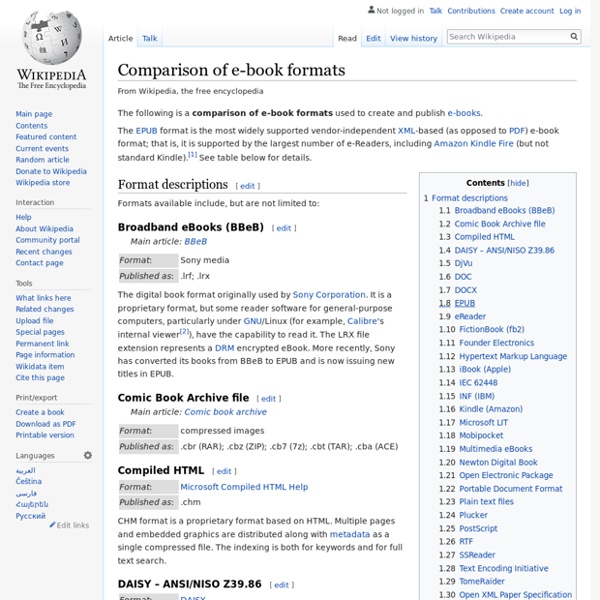Amazon Product In a Post Plugin
Amazon Products displayed on a page with the Post Content as part of the product (option 3 when setting up product). Shortcode Usage Page (new in 3.5.1). Outlines how to use the shortcodes for different setups. Getting Started Page (new in 3.5.1). Walk you through how to get and set up the Amazon Product API keys for the plugin.
E-book
An electronic book (variously: e-book, eBook, e-Book, ebook, digital book, or even e-edition) is a book-length publication in digital form, consisting of text, images, or both, readable on computers or other electronic devices.[1] Although sometimes defined as "an electronic version of a printed book",[2] many e-books exist without any printed equivalent. Commercially produced and sold e-books are usually intended to be read on dedicated e-book readers, however, almost any sophisticated electronic device that features a controllable viewing screen, including computers, tablet computers, and smartphones can also be used to read e-books. E-book reading is increasing in the US, since by 2014 28% of adults had read an e-book, compared to 23% in 2013. This is increasing because 50% of Americans by 2014 had a dedicated device, either an e-reader or a tablet, compared to 30% owning a device at the end of 2013.[3] History[edit] Bob Brown's The Readies (1930)[edit]
EPUB 3
EPUB 3 was developed pursuant to a charter approved by the IDPF Membership in May, 2010. EPUB 3.0 was approved by the IDPF membership as a final Recommended Specification effective October 11, 2011, and superseded the previous release of EPUB (2.0.1). This page contains information about EPUB 3.0 which as of as of June, 2014 has been superseded by EPUB 3.0.1, which is now the current version of the EPUB standard. The best starting point for learning about EPUB 3.0, including the roadmap to the specification documents, is the EPUB 3 Overview . The full list of the individual specifications comprising EPUB 3.0 is: An additional non-normative document describes:
How To Sell Ebooks
I just hit a milestone that is hard for me to grasp. As of January, I've sold over one million ebooks. The question I get asked more than any other is: How can I make my ebooks sell more copies?
The Best WordPress Amazon Plugin
This page contains all the available — there are over 50 plugins! The plugins fall under two main categories: Plugins for Internet and affiliate marketers .
E-reader
An e-reader, also called an e-book reader or e-book device, is a mobile electronic device that is designed primarily for the purpose of reading digital e-books and periodicals. Any device that can display text on a screen may act as an e-book reader, but specialised e-book reader designs may optimise portability, readability (especially in sunlight), and battery life for this purpose. A single e-book reader is capable of holding the digital equivalent of hundreds of printed texts with no added bulk or measurable mass.[1] Overview[edit] An e-book reader is similar in form to a tablet computer. A tablet computer typically has a faster screen capable of higher refresh rates which makes it more suitable for interaction.
Amazon Launches Kindle Singles, Saves Long-Form Journalism
Amazon has launched Kindle Singles, one-off pieces of non-fiction and journalism which are typically much shorter than a novel, but longer than a magazine article. The Singles can be read on any of the many Kindle platforms, from the Kindle itself through smart-phones to Amazon’s desktop Kindle client, and they are priced accordingly, from $1 to $5. Long-form journalism has seen a surprising revival in recent years, with services like Instapaper and Read it Later allowing you to push longer articles off to mobile devices – like the iPad – to read later.
The Evolution of eInk
Sure, smartphones and tablets get all the press, and deservedly so. But if you place the original mainstream eInk device from 2007, the Amazon Kindle, side by side with today's model, the evolution of eInk devices is just as striking. Each of these devices has a 6 inch eInk screen. Beyond that they're worlds apart. They may seem awfully primitive compared to smartphones, but that's part of their charm – they are the scooter to the motorcycle of the smartphone. Nowhere near as versatile, but as a form of basic transportation, radically simpler, radically cheaper, and more durable.
Publish your Blog as a Magazine with Google Currents
The Google Currents app that lets you read (and publish) blogs and other online publications in a magazine like format on your Android, iPad or iPhone. Google’s widely anticipated alternative to Flipboard is finally here. It’s called Google Currents and the next screenshot should you give an idea of what Currents is all about. Google Currents is a Flipboard like app that lets you read blogs, news websites and other online publications in a magazine format on your mobile phone and tablet devices. The app is available for both Android and iOS platforms. One big advantage with Google Currents is that you can read your subscriptions offline and it will even download the embedded images for offline access.
Launching a new idea in a post-paper world
Subscribe to our free email newsletter. We'll update you once or twice a week, and we'll never rent or sell your email address to anyone. Thanks. Today my new manifesto Stop Stealing Dreams goes ‘on-sale’.



